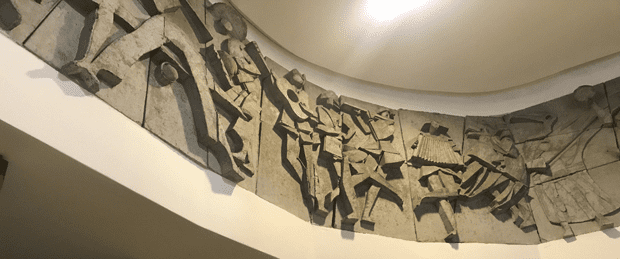Carybé: an introduction
Carybé, pseudonym of Hector Julio Páride Bernabó, was an Argentine-Brazilian artist. Born in Buenos Aires on February 7, 1911 and died in Salvador on October 2, 1997.
The Argentine moved to Salvador in 1949, where he established himself as an artist and writer, as well as a researcher of Afro-Brazilian culture. He was fascinated by the culture and folklore of Bahia, which he began to portray in his artistic work.
One of the most striking artistic techniques of Caribbean it was the creation of concrete panels that became a reference in Brazilian modern art. The artist's skill is the result of the union between a refined technique and a deep knowledge of the culture of the people of Bahia.
1. hall acts at the memorial of latin america
The Hall of Acts is one of the best-known works of Caribbean in Sao Paulo. One of the most important in the Memorial da América Latina, a cultural complex created by anthropologist Darcy Ribeiro and designed by Oscar Niemeyer.
Located in the Memorial's General Secretariat building, the Hall of Acts is made up of six concrete panels created by Carybé and Poty. Each panel measures 15 meters high.
The panels portray the culture and history of Latin America, highlighting the diversity and richness of the region's people. With names representing this historical narrative, they were baptized
- Panel of Pre-Columbian Peoples
- Panel of Afro Peoples
- Panel of the Iberians (or The Conquerors)
- Panel of Immigrants
- Libertadores Panel
- Builders Dashboard.
Of these, Carybé executed three: The African Peoples, The Iberians (or Conquistadors) and The Liberators. Meanwhile, Poty executed the panels The Pre-Columbian Peoples, The Builders and The Immigrants.
The Salão dos Atos is considered one of Carybé's most important works in São Paulo, due to its historical and cultural importance for the region. The panels were inaugurated in 1989 and since then have become one of the most visited tourist attractions in the Memorial of Latin America.


2. Casa Jorge Amado Foundation
This work was created in 1987 and is located at the entrance of Fundação Casa de Jorge Amado, in the historic center of Salvador, Bahia. The work is composed of three panels that represent the three races present in the history and formation of Bahia and Brazil. On the left, we have the figure of a European man, in the center, an African man and on the right, an indigenous man.
Carybé's work is an example of the connection between Brazilian modernism and the sociology of the time, more specifically that of Darcy Ribeiro. He was a leading Brazilian anthropologist and sociologist who studied the country's culture and society. Darcy Ribeiro argued that the source of national identity was a mixture of black, European and Indian races and cultures.
Brazilian modernism, which emerged in the early 20th century, also reflected this view. Artists such as Tarsila do Amaral, Candido Portinari and Anita Malfatti sought to portray the social and cultural reality of the country in their works of art. They were influenced by the anthropophagic movement, which proposed the “devouring” of foreign influences to create genuinely Brazilian art.

bráulio xavier building

(click to enlarge)
The mural “A Colonização do Brasil”, located on Rua Chile, in Edifício Desembargador Bráulio Xavier in Salvador, Bahia, was made by the artist Carybé in 1962 and is listed by IPHAN. The mural is approximately 15 meters high and 3 meters wide. Second report (newspaper mail, 2021), the work is being damaged by infiltration caused by lack of maintenance.

former hotel in bahia, current wish
In 2010, the Wish Hotel in Bahia received the title of Cultural Property of the State for its historical and cultural value. The hotel, which was reopened in 2013, features an environment with more than 350 works of art on display, in addition to being recognized as an example of architecture Brazilian modernist. Also noteworthy is its art gallery, which houses 370 works by renowned artists, including the magnificent panels by Carybé, created in 1984, and the mural by Genaro de Carvalho, from 1950.

castro alves theater foyer
As mentioned earlier on the blog, Teatro Castro Alves is known to everyone in Bahia architecture. It is a landmark of modern Brazilian architecture, designed by the Bahian Edgar de Oliveira da Fonseca.
The theater offers a wide variety of events including plays, musical shows, dance and other performances. In addition, the space is the stage for important cultural events, such as the Salvador Film Festival and the Bahia Dance Biennial.
The Castro Alves Theater is also known for its rich cultural and political history, having been the stage for important events, such as the show by Caetano and Gil in 1969 to raise funds for exile.
Something that is not difficult to notice quickly is the diversity of media that the work has: from concrete, dark, to tiles and light painting and wood as a halftone between both.

box office at nelson rodrigues theater
The Caixa Cultural unit on Avenida Chile, Rio de Janeiro, created in 1987, includes the Nelson Rodrigues Theater. The building, a landmark of the architecture of the 70's, has a pyramidal shape and is surrounded by gardens, walkways and reflecting pools.
The façade features bas-reliefs by Carybé and marble stones by Pedro Correia de Araújo Filho. Inside the Theatre, there are gigantic carved wooden panels by the artists Ernani Macedo and Roberto Sá and beautiful mosaics by Freda Jardim. The theater was inaugurated as Teatro do BNH on January 14, 1976 with the premiere of “Vestido de Noiva”, by Nelson Rodrigues, directed by Ziembinski. Four years after the death of Nelson Rodrigues, the BNH theater was renamed Teatro Nelson Rodrigues, in 1984.



Source:Carybé Institute (Facebook)




2 thoughts on “os painéis de concreto de carybé”